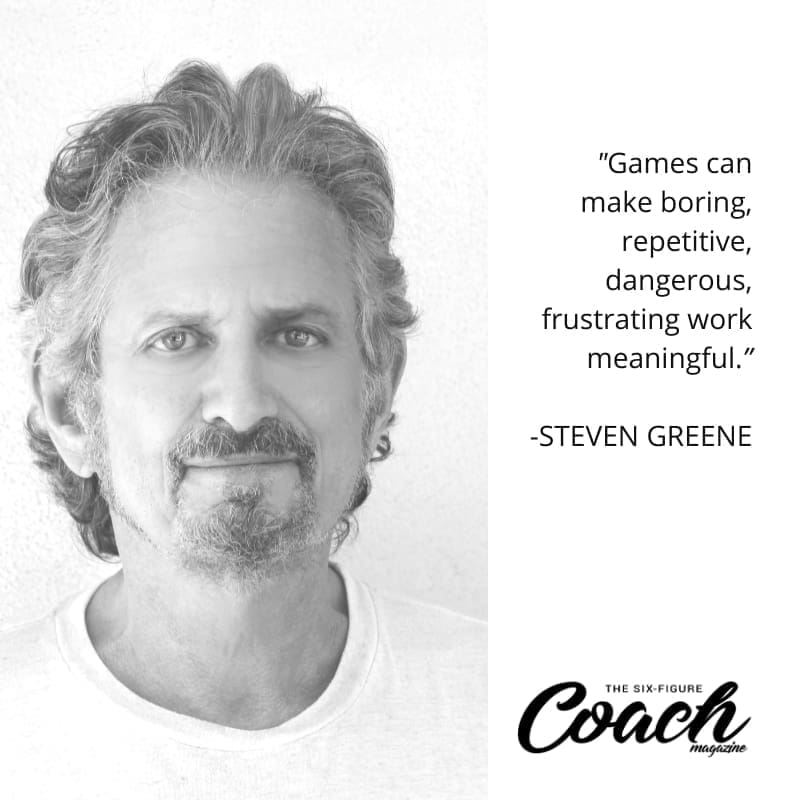Gamification An Easy Implementable Path To Success By Steven Greene
To keep it really simple, “GAMIFY EVERYTHING!”
The “why” is a long story. Let’s try and keep that story short.
We are a storytelling species. According to Jonathan Gottschall, who wrote the book, The storytelling animal: How stories make us human, the entire realm of human experience is made up of stories.
Before written materials were invented or widely available, we learned and taught through story. Early man used vocal sounds and gestures to tell a story. Medicine men and woman passed down rituals and cures through stories. Societal and family traditions are still passed down through stories. There are even a lot of stories in my books about success.
Through stories, we experience, explain, pass on information, and have fun.
Now since we operate through story, we can tell ourselves many different kinds of stories. They can be short, long, simple, or complex. The idea is that they always have a point of view and usually a lesson to follow.
In our personal and business lives, our stories invariably wind up in a predicament. We create or run into a problem. A great way to find an actionable way to the solution is to create – and then live – a series of short stories (chunks) where we can achieve a “small step” positive result. That’s called a game. That’s why I suggest turning every kind of challenge or problem into a game for a better outcome.
When in doubt, Gamify!
Why games? Problems, work, crappy things that come up in our business or personal life are not fun. Games are fun. Even the complicated ones that are hard. Even the ones that take us through a series of repetitive exacting steps to get to the end. Basically, games allow us to restate the problem in a more acceptable, solvable way.
It is telling ourselves or our clients a different story about things that are happening. Games allow us to tell the same story differently so we can engage with it in a positive way. A dull, miserable, uncomfortable, set of circumstances can become enjoyable!
Here is the most essential part of all this. GAMES ARE WINNABLE. Games are created with winning in mind. That’s a great dynamic to set up in your personal or business life… a template for success.
In addition, good game mechanics provide feedback, i.e. “what went wrong” so there is a correction pathway to fix mistakes. Also, games are hard. That’s good when you want to use them to help you solve real life problems.
Here is a great takeaway
Games make failure fun! According to a recent bingo cash review, by turning a set of tasks into a game, we can quickly fail our way to success.
How does that work? In a game, 80% of the time, gamers fail. They don’t complete the task, don’t solve the puzzle, they run out of time, lose, or die.
But people keep playing because in the game world failing and learning a little bit in each iteration of the game is challenging and fun. Also, in a game, you have a measure of control. You are in charge.
Games have new levels and problems that can be mastered. They have a flow that you can get into in order to achieve a clear and desired goal. That goal can be broken up into mini-goals with all the small goals leading to the desired giant goal outcome.
Games like satta king 786 can make boring, repetitive, dangerous, frustrating work meaningful.
For centuries athletes have trained for hours a day and soldiers have fought and died, only to be rewarded with a metal disc on a piece of ribbon.
People make 100 excruciating phone calls a day to make one sale and get their name on a leaderboard. Immediate celebration of wins with badges and boards works.
More good news. Games are addictive. So if you can gamify a business process for your employees, a sales funnel or app for your customer’s, chances are they will stick better with the game scenario than with some other feedback methodology.
Does it really work? Check out Samsung Nation, Starbucks, Jillian Michaels Fitness, Heineken, and the U.S. Army. Businesses like Foursquare were founded on gamification of how we navigate our lives. Over 50% of all size startups in 2019 said gamification was a major component of both their marketing and their employee initiatives.
Bells or badges
So, here is a toolset that can easily be applied to our personal and business lives to make processes more effective. It isn’t difficult or expensive to chunk our tasks down into pieces. Those pieces can become tasks to be accomplished one after the other with small acknowledgments for getting them done. It’s not silly or simplistic. It works.
From my personal experience, I can recall many years ago when my lowly job was calling a list of very unreceptive business owners and attempting to sell them toner for their copy machines.
This was not a fun job. The work environment was a hot, crowded room filled with every unemployable weirdo “wanna be someone else” that Los Angeles could cough up. The bosses looked like they should be cast in a movie as two tattooed muscle heads who just escaped from prison.
In reality,
They did not escape, they had been recently released. I’m sure… not for good behavior! I was about ready to jump out of the window to get out of there but then I made a sale. It was for 19 toner cartridges. They were $89.95 each. The total sale was $1709.05. In those days that was a whale sale.
It wasn’t the 22% commission that got me excited and kept me at that job for quite a while even though that one sale paid my rent for a month. It was the bell. “Management” had a giant replica of the Liberty Bell (crack and all) swinging in the front of the room. When the deal closed they clanged the bell 19 times and yelled “Steven Greene closed
19 just now.” That was it. I was a winner. After that, I became a star salesman. Lots of bell ringing and other stuff which I will save for another article. However, this example from the early 80s is my personal proof that simple gamification is a winner for us all.
Scientific front
On the scientific front, advancement and small rewards in games produce dopamine, the feel-good hormone, in all of us. Successes in the form of bells or badges release serotonin. Serotonin elevates overall mood.
The excitement of playing games releases endorphins that reduce stress and anxiety. Games increase brain plasticity. That’s the ability of the brain to modify itself when needed, even in older age. These are all great additions to a positive learning and success environment.
Reasons to gamify
To sum up, here are the reasons to gamify, whether it’s in your business or helping your kid with homework. Gamification helps us all stay with and complete tasks. When we gamify, we become engaged because games tickle our emotional triggers. We naturally become more involved an immersed in games than we do in ordinary day to day activities.
Games are enjoyable.
The small incremental wins make us feel in control while engendering a sense of optimism. In addition, games offer a platform for healthy competition where achievements can be shared among peers. Games provide an opportunity to celebrate small rewards that may have little value or significance in general, but are coveted and highly valued to the game participants.
Become a winner and gamify whenever you can!


About Steven Greene
Steven is a published author and produced screenplay writer. He is the winner of numerous prestigious awards. His “out of the box” innovative thinking, true creative credentials, along with C level experience and influence have enabled him to produce added value for clients, in addition to becoming sought after as a corporate speaker and consultant.
Reach him at steven@clickfirstmedia.com



